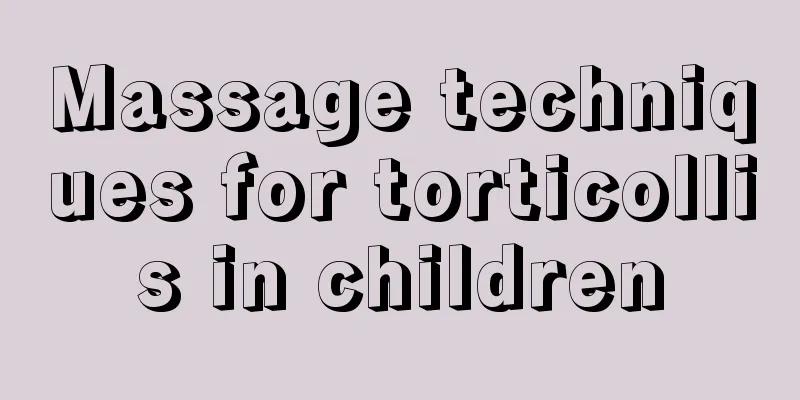Massage techniques for torticollis in children

|
As a newly emerging industry, pediatric torticollis massage has become popular all over the country. Many of our parents and friends now attach great importance to pediatric torticollis massage. In fact, this is also an issue that parents and friends must pay attention to. Many parents and friends have various neck problems as a result of not paying attention to maintenance. Children’s diseases have caused great trouble to our male friends. Now there is a new massage method, pediatric torticollis massage technique. This massage can effectively solve many problems of our children. I believe that many people are not familiar with pediatric torticollis massage technique. Let us learn about pediatric torticollis massage technique together! Massage techniques: 1. Common massage techniques (1) According to the method. Use your fingers or palms to apply a certain amount of pressure to the acupuncture points or certain parts of the body surface, pressing downward or inward and outward. The method of pressing on a small area is also called the point method. (2) Mofa. Use your thumb or palm to rub the injured area (mostly soft tissue) or acupoint repeatedly. (3) Inference method. Use your hands or palms (mainly the pads of the thumb and little finger or the base of the palm, etc.) to push the patient's muscles outward or perform forceful linear massage. Pushing on the spine is also called spinal pushing. (4) How to hold it. Use one or both hands to hold the affected muscles, squeeze them, or lift the muscles and then quickly let go. The latter is also called "elastic tendons". (5) Kneading method. Use the tip of your thumb or the base of your palm to press on a certain part, mainly the wrist joint or metacarpophalangeal joint, and make circular kneading movements. (6) Pinching method. Pinch the acupuncture points with your thumb nail and apply pressure to a certain degree. (7) Rubbing method. Use the palms of both hands to hold the limbs or waist and back tightly, and move the skin and flesh in quick rubbing and repeated up and down circling movements. (8) Shaking method. Use both hands to firmly hold the two ends of a joint (mainly larger joints such as the neck, shoulder, elbow, wrist, hip, knee and ankle), and shake the joint from both ends, making circular motions to enhance the mobility of the joint. (9) Rolling method. Use the back of your hand near the little finger to press on a certain part of the body surface, and roll the wrist forward, backward, left and right continuously. (10) Shaking method. Hold the distal end of the injured joint with your hands (both hands or one hand) and swing it up, down, forward, and backward at the same time while pulling it outward. The range of activity must be within the physiological range. Often used around the waist or shoulders. (11) Touch method. Use both hands to carefully touch the injured area and the surrounding area, rely on the sense of touch to check the actual extent of the injury, and check for any positive signs (cords, nodules, etc.). (12) Wording. Lift the patient's injured and hanging limbs lightly or heavily by hand (or rope). Care must be taken to move from reverse to forward to avoid causing new damage. (13) Pulling method. Use both hands or other objects to apply force in opposite directions to stretch and separate the injured, contracted and overlapped muscles. You must maintain moderate force to avoid causing new injuries. (14) Rafa. Generally, the force is applied in parallel to straighten the tendons and help to massage and straighten them out. (15) Shaking method. Shake gently to loosen and separate the injured and adhered bone and flesh tissues. (16) The law. Restoration of dislocated, broken or deformed limbs (usually should be performed by a professional physician). (17) Shooting method. Use moderate force and tap the affected area steadily and rhythmically with your hollow palm. You can clap with one hand or two hands. (18) Kneading. Use two fingers to pinch the surface of the skin and lift it up, then roll forward step by step. The above content introduces us to the massage techniques for torticollis in children. Through the above content, our parents and friends can learn some small methods and perform simple and effective massages at home to keep diseases away from our children. I hope that parents and friends can benefit from the above content. At the same time, I also hope that everyone can share the above methods with more of our friends. |
<<: Treatment of gastric torsion in infants
>>: How to make steamed apples for baby diarrhea
Recommend
How to deal with eczema after it scabs
Eczema is a very common skin disease. It is very ...
Reasons why babies stretch
Many physical conditions of infants will not be m...
Will children have dark blue stools after taking anti-inflammatory drugs?
After a baby is born, it is common for him to get...
What is the cause of the child's arrhythmia?
Everyone knows that heartbeat is regular. When ma...
What should I do if my three-year-old child has chronic constipation?
Constipation is a very common phenomenon. Almost ...
How to prevent cerebral palsy in infants and young children
Every baby is a little angel given by God to thei...
There is a hole on the back of the baby's head. What's going on?
As children grow up, parents will encounter vario...
What are the precautions for baby travel?
Autumn is the best time to travel. Autumn is comi...
What should I do if my child keeps coughing?
Once a child starts coughing, we all feel very wo...
What is bedwetting in children?
Children's bedwetting is not necessarily caus...
How to change a child who is introverted and doesn’t like to talk?
The child is introverted and doesn't like to ...
Can children take antiviral drugs in emergency room?
Infants and young children generally have low bod...
What to do if your child's armpits have odor?
We sweat normally, and usually we feel a bad smel...
What to do if your child has a cough and hoarseness
Nowadays, most families have only one child, so t...
How to deal with concussion in young children?
Children are the flesh and blood of their mothers...









